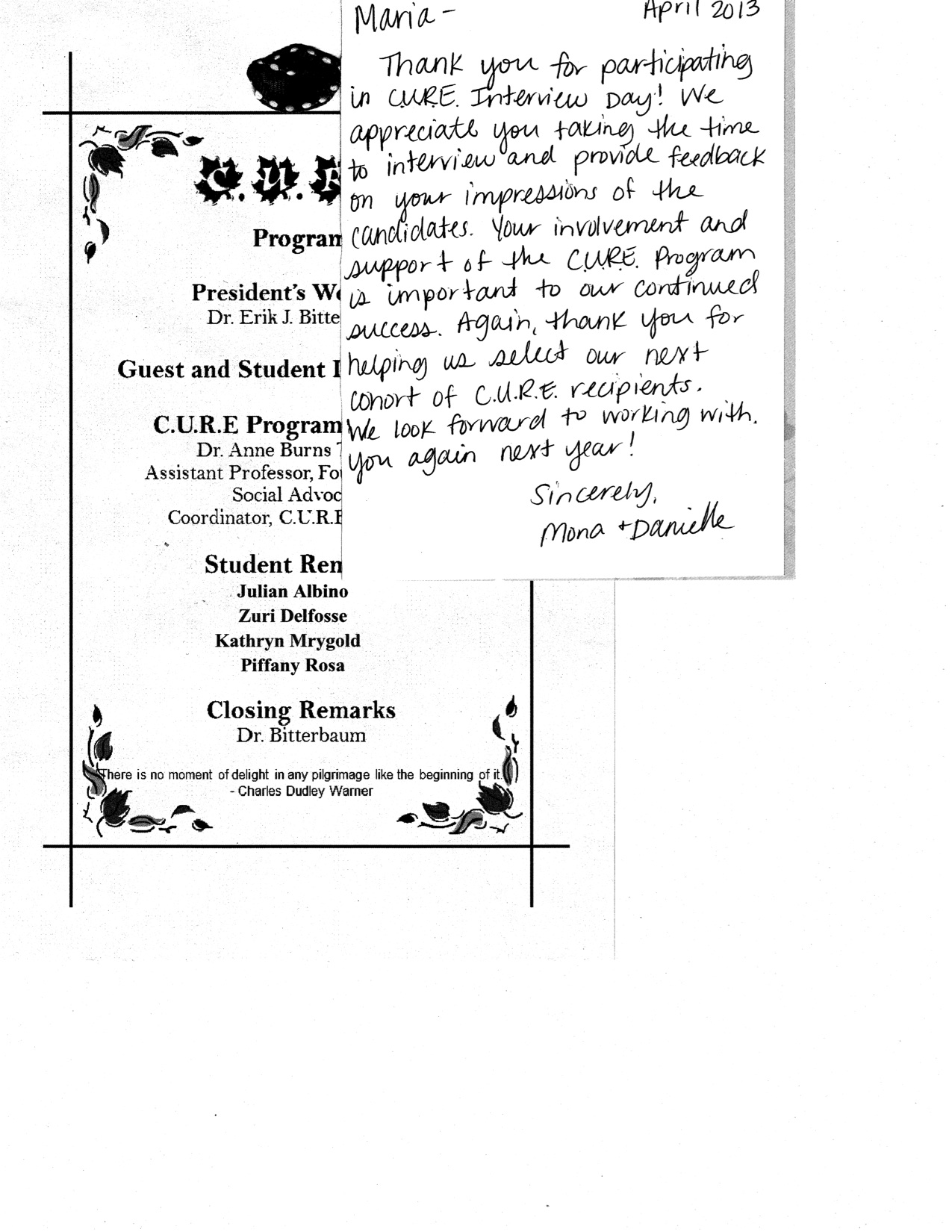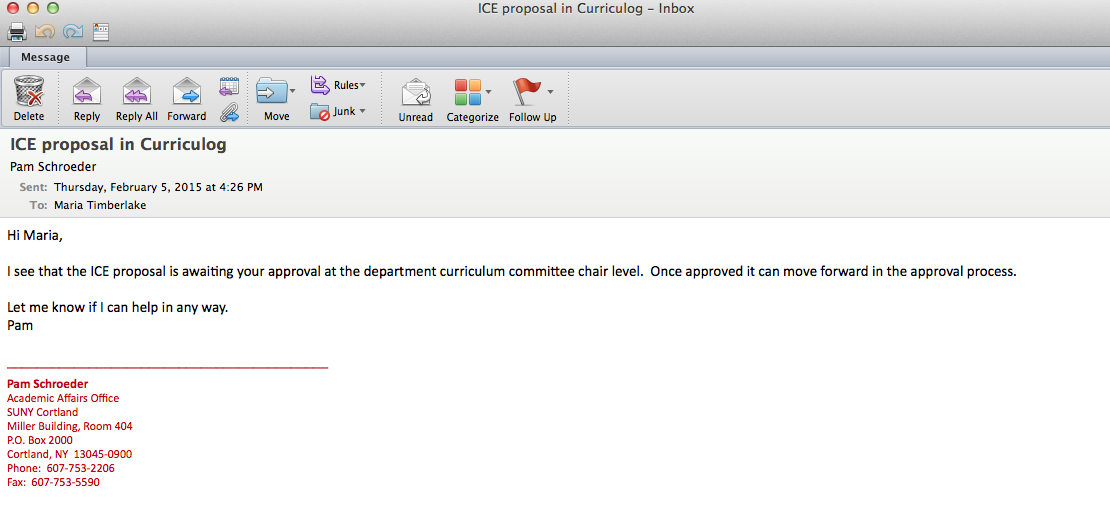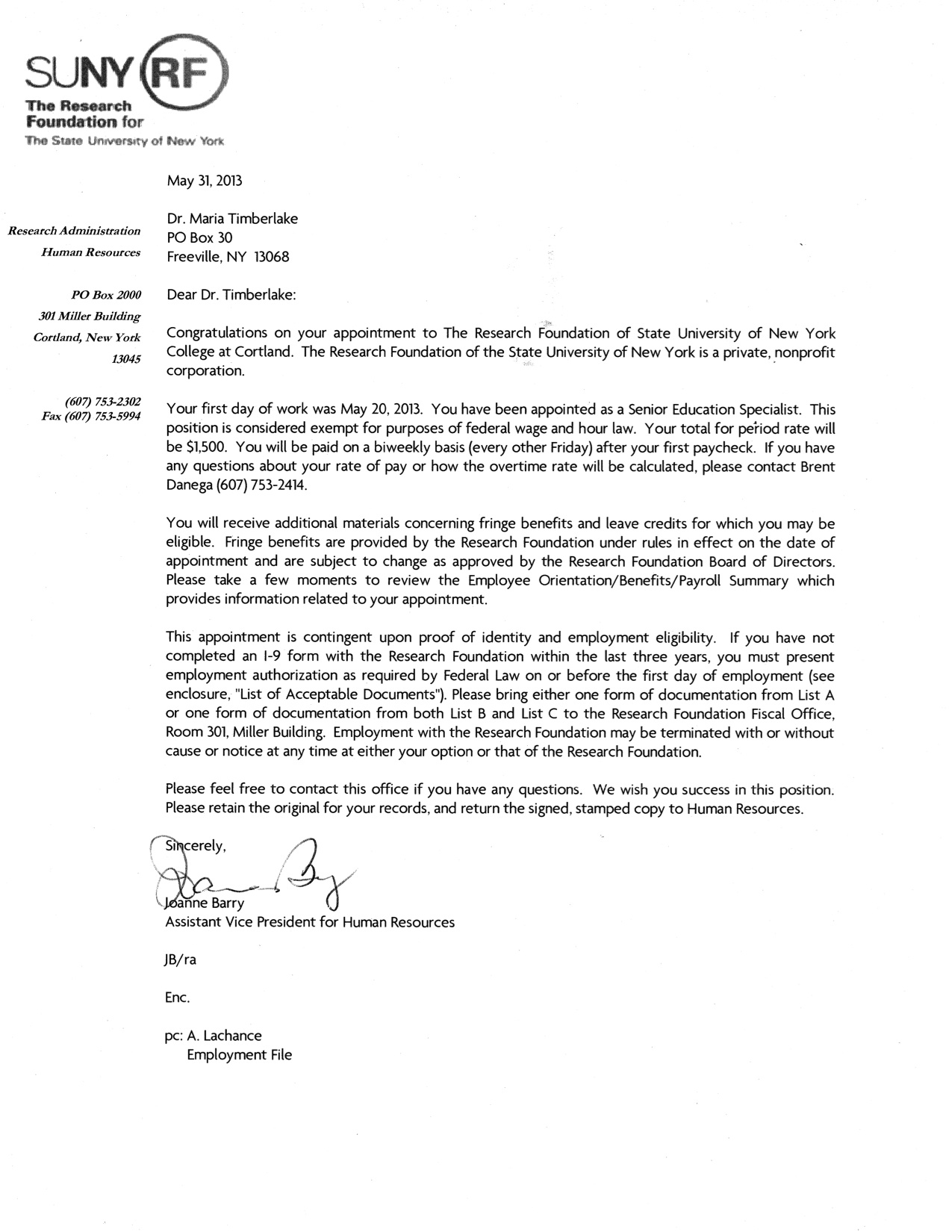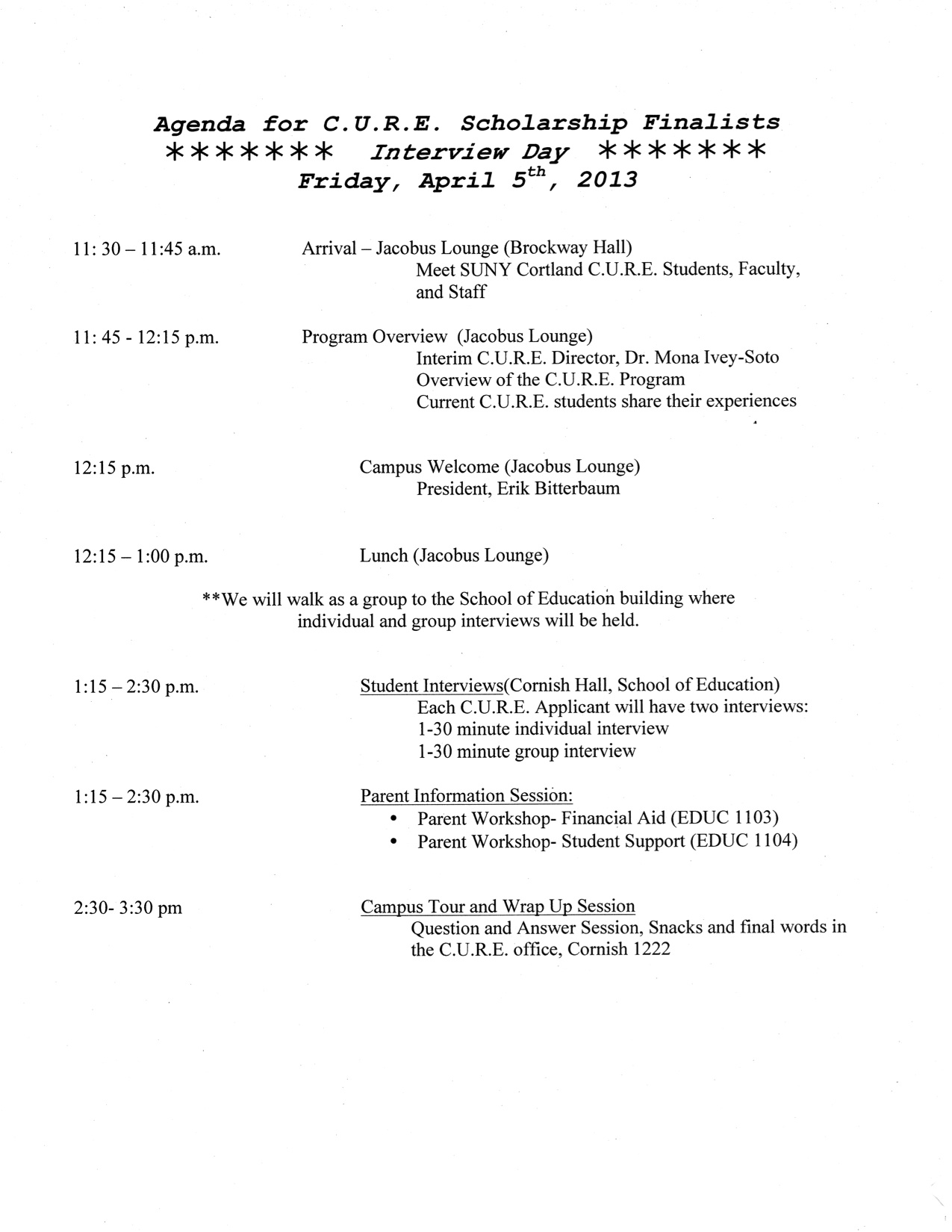Department level:
Chair of the Foundations & Social Advocacy Curriculum Committee.
I developed a new course, FSA 340 in June and July 2013, assisted with the SPA report writing in the fall of 2013 and interviewed CURE applicants in the spring of 2013.
Developing FSA 340 was intellectually and creatively interesting as my charge was to merge three separate classes (families, assistive technology and “severe” disabilities) into one new course. I developed the course as part of SUNY’s research foundation. Please click here to see FSA 340: https://maria-timberlake.com/developing-fsa-340/
Working on the SPA report gave me a picture of the courses offered by the department and the relationship between our courses, the CEC Professional standards and the assessments. David Smukler & Ji-ryun Kim did the majority of the writing, but an excerpt from my contribution to the SPA report is below (in blue):
SUNY Cortland Inclusive Special Education SPA Report
Section IV – Evidence for Meeting Standards: Appendix 6
Assessment 6 (Required)
Additional assessment that addresses CEC standards
6.2: Description of How Assessment Specifically Aligns with Standards It Is Cited For in Section III (Language reflecting the particular standard below is in bold.)
Standard 5 (Learning Environments and Social Interactions) – The Positive Behavioral Support Assignment requires candidates to develop interventions based on systematic analysis of a pattern of behavior that is of concern. The interventions must include a number of strategies, with a particular emphasis on prevention strategies, and learning strategies (helping students develop alternatives to the behavior of concern). Prevention strategies consider the demands of learning environments; the candidates consider spatial, temporal and procedural aspects of the environment for effective management of teaching and learning. Learning strategies teach social skills needed for educational and other environments. Strategies to respond effectively to problem behaviors without escalating them prepare the candidate for crisis prevention and intervention.
Standard 7 (Instructional Planning) – Candidates analyze a difficult pattern of behavior, and plan interventions based on their hypothesis about the behavior’s function. Behavior is treated as communicative, and the functions of behavior are assumed to be legitimate human needs, even if the target student’s attempt to meet those needs results in difficult behavior. The assignment requires the candidate to use functional assessments to develop intervention plans. An expectation to develop multiple strategies on the behavior intervention plans means that candidates are required to integrate academic instruction and behavior management for individuals and groups with disabilities. Planning is considered effective to the extent that it allows the student to meet such needs in ways that are less problematic.
Standard 8 (Assessment) – In order to determine the function of the target student’s pattern of behavior, candidates use a combination of observation and conversation with those who know the student best in order to gather relevant background information. Both appropriate and problematic social behaviors of individuals with disabilities are considered. A variety of assessment formats are considered in class, and candidates select, adapt and modify assessments to accommodate the unique abilities and needs of their target student. Evaluation of data is purposely postponed in order to allow for a data gathering process that is as neutral as possible. A variety of assessment formats are considered in class, and candidates select assessment approaches based on consideration of the individual situation of their target student.
Standard 9 (Professional and Ethical Practice) – The assignment concludes with a written reflection about the process of analyzing a complex pattern of behavior. Candidates consider the range of possible teacher responses to behavior with regard to effectiveness, ethical issues, and the question of controlling students’ behavior versus helping students to develop stronger self-control. The reflection requires candidates to use written language effectively and to reflect on their practice and conduct self-evaluation of instruction in order to improve instruction of students with disabilities (and others) who engage in complex behavior.
6.3: Brief Analysis of Data Findings (see tables below in 6.5 (c))
The majority of the 50 candidates met or exceeded expectations on all criteria. Our candidates were most likely (92%) to meet or exceed the standards in gathering data about children’s behavior and analyzing the meaning of the behavior in context. Although 89% of candidates met or exceeded the standard in preventative strategies, these data suggest room for improvement in helping candidates think about children’s self direction, motivation and independence. 75% of our candidates met or exceeded the standard for developing response strategies and intervening with individuals in crisis, suggesting some room for improvement. However, it is important to note that the same candidates consistently improve their ability to respond to difficult behavior during their student teaching semester. The strongest area is our teacher candidates’ ability to be reflective about their practice, with 100% meeting or exceeding standards.
6.4: Interpretation of How Data Provide Evidence for Meeting Standards
This assignment is designed to address CEC standards 5, 7, 8 and 9. In general our candidates show strong assessment skills with regard to students’ behavior, and are very reflective about the basis of students’ behavior and its context. They are less strong when it comes to developing specific strategies at this stage in their development, but tend to gain many of those skills when they student teach. Although most candidates met the criteria for Standard 5 (learning environments and social interactions) a quarter of our students did not demonstrate an adequate knowledge of safe and positive strategies when faced with difficult student behavior. Developing a repertoire of positive response strategies requires a re-thinking of traditional punitive-oriented approaches as well as exposure to a variety of students and classrooms in order to understand the communicative messages in behavior and the options for responding. The fact that 75% of our students meet this standard indicates that the course preparation is effective but reminds us that responding to problem behavior is difficult for beginning teachers and may require additional practice within our courses. The 92% of candidates who meet or exceed Standard 7 (instructional planning) illustrate that candidates are adept at analyzing environments to assess what might be contributing to challenging behavior and how it might be prevented. Candidates’ performance on standard 8 (assessment) and standard 9 (professional and ethical practice) is generally stronger as reflected by higher numbers of candidates meeting and exceeding expectations on assessing problem behavior, reflecting on their own attitudes and behaviors as well as what they observe in children, and writing expectations for the assignment.
Next, I was happy to be part of interviewing potential CURE participants in 2013 and 2014 (see invite below). I learned more about the CURE program overall and was moved by my interviewees passion to be urban educators. I also attended the celebration at the Alumni House in the fall of 2013 and 2014 because one of the students I interviewed and one of my FSA 210 students were featured speakers.
 2. My service at the College of Education level consisted of my seeking to strengthen the PDS model between the College and Parker & Barry Elementary Schools in Cortland. I’d like to highlight three specific activities:
2. My service at the College of Education level consisted of my seeking to strengthen the PDS model between the College and Parker & Barry Elementary Schools in Cortland. I’d like to highlight three specific activities:
(1) I went to both schools on consecutive Friday afternoons, walked through the halls, introduced myself to teachers, told them about FSA 210 and directly asked if they’d consider hosting a student and how much it would mean. Their principal had asked for volunteers, but I wanted to move the process along and establish a more personal connection;
(2) I checked in periodically with each teacher and asked about the specific student he or she was hosting, as opposed to a general check in of “the students”; Here is a representative sample of teacher emails:
https://maria-timberlake.com/pds-teachers/
(3) The FSA 210 students and I wrote thank you cards to each individual teacher in both Parker & Barry School at the end of the semester to thank them for hosting.
3. At the University level I am a member of the Technology Accessibility Committee. The committee looks at accessibility college-wide, from our website, to how faculty make their texts and assignments accessible to students with disabilities, to legal requirements for digital text, to examining the purchasing of software and equipment with accessibility in mind.
Click here to see an agenda for this committee:
https://maria-timberlake.com/tac-sample-agenda-notes/
In addition to committee meetings I attended a summer workshop with Jeremy. Zhe-Heimerman and Michelle Cryan. Here is the conference flyer and a photo of my notes that I shared with the Committee.
https://maria-timberlake.com/tech-access-conference/
I am a member of the Education Policy Committee, the Teaching Effectiveness Committee and the Teacher Education Candidate Review Committee.
4. Other work with students undertaken in addition to the formal teacher-student relationship:
I have written the following letters of recommendation:
- professional for ST., T.B, LH graduate students
- undergrad students: N.E, (international internship) K.S ,LB,MW (on campus position) & K. M.(scholarship)





